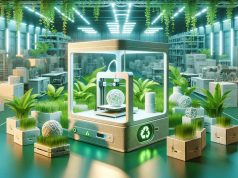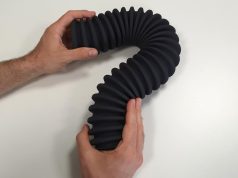The Fraunhofer Institute for Laser Technology ILT and Rapid Shape GmbH are working together to further develop resin-based 3D printing. The new “TwoCure” process requires no support structures and is significantly more efficient and productive than conventional 3D printing techniques for plastic components. Experts from Fraunhofer ILT will be presenting the state-funded joint development that makes use of the interaction of light and cold in forming the components at formnext 2017 from November 14 to 17 in Frankfurt am Main.
Much like stereolithography, one of the best-known processes for printing 3D plastic components works using photolithographic light exposure that causes liquid resins to harden layer by layer. This additive process has one significant disadvantage however: it requires supports that the user must include in the design, then construct during the process, and then laboriously remove from the product.
As part of a Central Innovation Program for SMEs (ZIM) project funded by the German Federal Ministry for Economic Affairs and Energy, Fraunhofer ILT is collaborating with Rapid Shape GmbH* in Heimsheim to develop an efficient alternative to this process. A liquid resin is still used and is applied layer by layer to a resin reservoir. Similar to other systems built by Rapid Shape GmbH, an LED light unit illuminates the liquid resin in the component’s layered geometry. “Much like with a projector, an image is projected into the resin bath and the polymer hardens in the areas that are illuminated. The resin in other areas initially remains liquid,” explain Holger Leonards and Andreas Hoffmann, project managers at Fraunhofer ILT.
“Free-floating” Components Created in the Build Volume
Supports were used up to now because the plastic structures, which are often delicate, would otherwise collapse. “Users dislike these process-related supports because additional CAD preparation and time-consuming follow-up work delay the production process,” says Andreas Geitner, technical director at Rapid Shape GmbH. The process developed in cooperation between research and industry not only does without supports, it also enables components to be positioned in the entire build volume without being connected to the platform. “Furthermore, we can create 3D components directly in the build volume, anywhere we choose,” Holger Leonards explains. “The components no longer have to be built on platform. Because the total build volume is being used more efficiently, each 3D printing job can create significantly more parts.”

© Fraunhofer ILT & Rapid Shape GmbH.
The scientists from Aachen and their industrial partners are making use of hybrid technology: they solidify the liquid monomer photochemically by means of light and thermally by means of cold. “The material is applied warm and then irreversibly cured by light,” says Leonards. “At the same time the cooled installation space ensures that the thermoset component being created layer by layer freezes to form a block with the resin that has solidified like wax.” The user can subsequently liquefy this at room temperature, so that the support material drains off: what remains are the 3D printed components that just need to be briefly cleaned and post-cured. The aim in future is for these steps to be automated in a process chain too.
“TwoCure”: First System for Making Jewelry
Because two curing procedures are used, the development stage process is called “TwoCure”. The idea for the process was born in a joint workshop. For this new type of 3D printing, the material and photochemical process were developed by Fraunhofer ILT, whilst the procedure and systems technology were successfully realized by Rapid Shape GmbH. The first prototype has already been built and should soon be ready for series production. This new kind of polymer 3D printing was successfully tested with models for the jewelry industry. These models are used to create jewelry rings, for example. According to Andreas Schultheiss: “Jewerly manufacturers have so far used supports to create their models and then removed them in a very laborious process before smoothing the surface. These last two production steps are expensive and superfluous. The new process means they will not be needed in future.”
Fraunhofer ILT at formnext
The first “TwoCure” components and information about the process are being presented by our scientists at the Fraunhofer joint stand at formnext (hall 3.0, booth F50) in Frankfurt am Main from November 14 to 17, 2017.
*The Schultheiss GmbH has implemented the ZIM project and is marketing the technology via its cooperation partner Rapid Shape GmbH.
Subscribe to our Newsletter
3DPresso is a weekly newsletter that links to the most exciting global stories from the 3D printing and additive manufacturing industry.






















